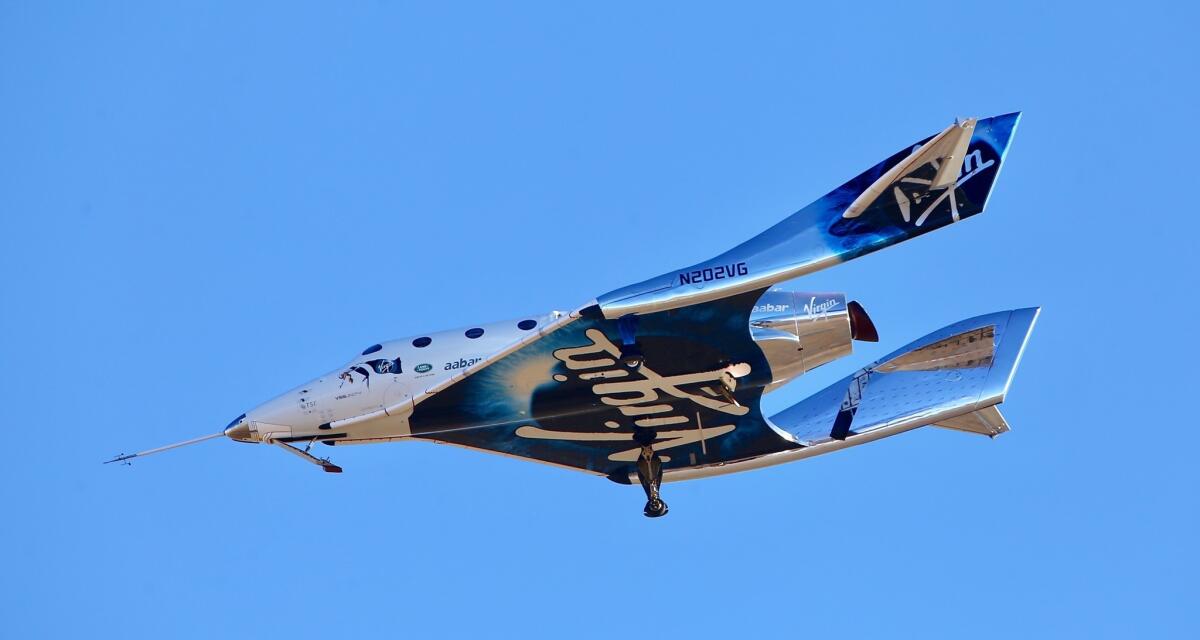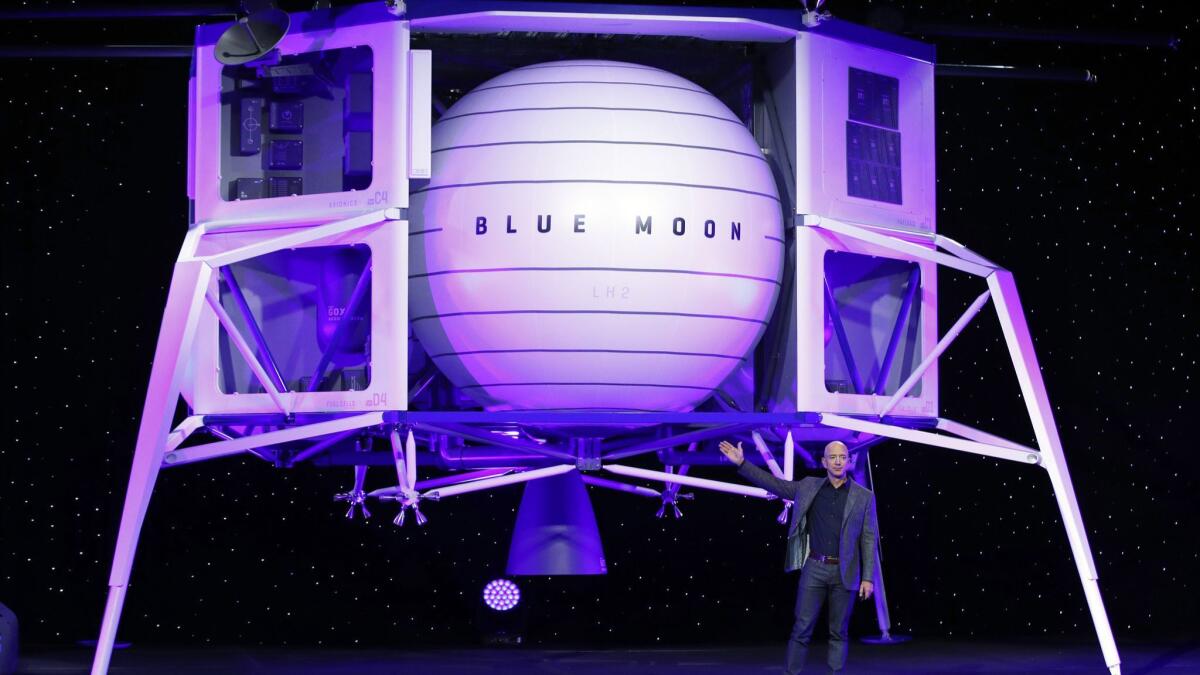Can we get to space without damaging the Earth through huge carbon emissions?
- Share via
When a SpaceX Falcon Heavy rocket blasts off on a plume of white smoke, hot gases shoot out of its 27 engines, creating a thrust equal to 18 Boeing 747 aircraft.
Upon reaching orbit, the world’s heaviest operational rocket will have burned about 400 metric tons of kerosene and emitted more carbon dioxide in a few minutes than an average car would in more than two centuries. That kind of shock to the atmosphere is stoking concerns about the effect that launching into orbit has on Earth, and it’s about to get worse.
Fueled by surging data transmissions and the race for commercial space flights between Elon Musk’s Space Exploration Technologies Corp., Jeff Bezos’ Blue Origin and Richard Branson’s Virgin Galactic Holdings Inc., the number of launches — including giants such as the Falcon Heavy and new mini-rockets — is expected to increase tenfold to roughly 1,000 annually in the coming years.
Although there are no regulations on rocket emissions, new space pioneers are taking it upon themselves to develop launchers that make leaving the atmosphere less damaging to the planet. It’s less space cowboy and more space boy scout.
“Climate change is real, and we don’t want to make it worse,” said Chris Larmour, chief executive of British rocket maker Orbex. The start-up, founded in 2015 and which has a contract with U.S. launch integrator TriSept Corp., uses bio-propane that it says can cut CO2 emissions by 90% compared with traditional launch fuel.

Besides greenhouse gas pollution, kerosene-fueled rockets transport large amounts of black carbon, also known as soot, into the upper layers of the atmosphere. There, it remains for a long time, creating an umbrella that may add to global warming. The fuel is widely used because it’s easier to handle than fuels such as hydrogen.
“So far the only criteria for everyone to build rockets was performance and cost,” said Jean-Marc Astorg, director for launch vehicles at French space agency CNES. “Environment was not a priority at all. That’s changing.”
The urgency to clean up rocket emissions is intensifying. Last year, the space industry launched 443 satellites, more than three times as many as a decade earlier, according to the United Nations Office for Outer Space Affairs. Planned missions to the moon and Mars will increase the strain on the environment.
SpaceX alone is planning to launch 12,000 satellites in the next seven years for its Starlink internet constellation. The company is developing the methane-powered Raptor engine, burning the greenhouse gas with a view to refueling on Mars. Blue Origin’s strategy is potentially more environmentally friendly, with plans for liquid hydrogen to propel its reusable rockets.
Even SpaceX and Boeing, which have accomplished great engineering feats, are still grappling with the tech.
Virgin Galactic says its plans represent a “new age of clean and sustainable access to space.” The company relies on lightweight spaceships that can fly hundreds of times to mitigate its environmental effect and says its rockets burn for only 60 seconds. The carbon footprint for passengers will be in line with a transatlantic business-class seat, it says.
ArianeGroup is going a step further. Europe’s biggest launch company is working on a rocket that aims to be carbon-neutral by running on methane produced from biomass. Dubbed Ariane Next, the heavy-launcher project targets liftoff in 2030.
“The rest of the world is lagging Europe so far on the environment performance of their future engines and launchers,” Astorg said.

Smaller challengers such as Orbex are moving quickly. The company, which is funded by a mix of venture capital and public funds, plans to have its Prime rocket take its maiden flight at the end of 2021. In addition to cutting CO2, the rocket will completely avoid black carbon, which is a “much bigger climate problem,” Larmour said.
Reducing soot and CO2 by 25% to 40% is more realistic, said Daniel Metzler, CEO of the German rocket start-up ISAR Aerospace, founded in 2018. His rocket — also scheduled to lift off in late 2021 — will decrease soot pollution by using a liquid fuel based on a light hydrocarbon, Metzler said, declining to provide specifics.
Such aggressive reductions in soot pose design and production challenges because the fuel residue has the positive side effect of protecting the inner surface of the combustion chamber against heat, the 27-year-old engineer said. ISAR addresses the problem by guiding the in-flowing fuel through a system of channels to cool the engine. Like Orbex, the company relies on 3-D printers to create the complex structures.
Elon Musk and SpaceX have staked their legacy on a spaceship capable of carrying a hundred passengers to Mars.
Rocket Factory Augsburg, a unit of German satellite maker OHB, took environmental issues into account from the start in developing its “mini-launcher,” an emerging trend in the aerospace industry. The rocket — developed for transporting small satellites and scheduled to perform its maiden flight next year — is using a new environmentally friendly propellant.
All of the ingredients are “available in a do-it-yourself-store,” and the design has the potential to avoid hydrazine, a highly toxic liquid used to fuel upper stages and satellites, Chief Engineer Stefan Brieschenk said.
The RFA launcher is designed to “avoid CO2 and soot as much as possible” because it’s the right thing to do, the 34-year-old said. “We are all young people, and we want to make a change now.”
Joern Spurmann, RFA program manager, sums up the new approach to the space race: “We’re following the boy scout rule that says: Leave the campground cleaner than you found it.”
More to Read
Inside the business of entertainment
The Wide Shot brings you news, analysis and insights on everything from streaming wars to production — and what it all means for the future.
You may occasionally receive promotional content from the Los Angeles Times.












